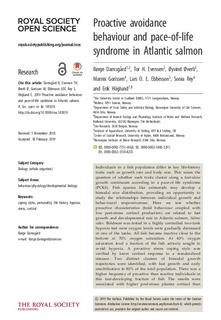| dc.contributor.author | Damsgård, Børge | |
| dc.contributor.author | Evensen, Tor Hatten | |
| dc.contributor.author | Øverli, Øyvind | |
| dc.contributor.author | Gorissen, Marnix | |
| dc.contributor.author | Ebbesson, Lars O.E. | |
| dc.contributor.author | Rey, Sonia | |
| dc.contributor.author | Höglund, Erik | |
| dc.date.accessioned | 2019-06-26T12:30:55Z | |
| dc.date.available | 2019-06-26T12:30:55Z | |
| dc.date.created | 2019-06-20T16:15:57Z | |
| dc.date.issued | 2019 | |
| dc.identifier.citation | Royal Society Open Science. 2019, 6 (3), 181859. | nb_NO |
| dc.identifier.issn | 2054-5703 | |
| dc.identifier.uri | http://hdl.handle.net/11250/2602332 | |
| dc.description.abstract | Individuals in a fish population differ in key life-history traits such as growth rate and body size. This raises the question of whether such traits cluster along a fast-slow growth continuum according to a pace-of-life syndrome (POLS). Fish species like salmonids may develop a bimodal size distribution, providing an opportunity to study the relationships between individual growth and behavioural responsiveness. Here we test whether proactive characteristics (bold behaviour coupled with low post-stress cortisol production) are related to fast growth and developmental rate in Atlantic salmon, Salmo salar. Boldness was tested in a highly controlled two-tank hypoxia test were oxygen levels were gradually decreased in one of the tanks. All fish became inactive close to the bottom at 70% oxygen saturation. At 40% oxygen saturation level a fraction of the fish actively sought to avoid hypoxia. A proactive stress coping style was verified by lower cortisol response to a standardized stressor. Two distinct clusters of bimodal growth trajectories were identified, with fast growth and early smoltification in 80% of the total population. There was a higher frequency of proactive than reactive individuals in this fast-developing fraction of fish. The smolts were associated with higher post-stress plasma cortisol than parr, and the proactive smolts leaving hypoxia had significant lower post-stress cortisol than the stayers. The study demonstrated a link between a proactive coping and fast growth and developmental ratio and suggests that selection for domestic production traits promotes this trait cluster. | nb_NO |
| dc.language.iso | eng | nb_NO |
| dc.publisher | Royal Society | nb_NO |
| dc.rights | Navngivelse 4.0 Internasjonal | * |
| dc.rights.uri | http://creativecommons.org/licenses/by/4.0/deed.no | * |
| dc.title | Proactive avoidance behaviour and pace-of-life syndrome in Atlantic salmon | nb_NO |
| dc.type | Journal article | nb_NO |
| dc.type | Peer reviewed | nb_NO |
| dc.description.version | publishedVersion | nb_NO |
| dc.rights.holder | © 2019 The Authors | nb_NO |
| dc.source.volume | 6 | nb_NO |
| dc.source.journal | Royal Society Open Science | nb_NO |
| dc.source.issue | 3 | nb_NO |
| dc.identifier.doi | 10.1098/rsos.181859 | |
| dc.identifier.cristin | 1706555 | |
| cristin.unitcode | 7464,20,15,0 | |
| cristin.unitname | Akvakultur | |
| cristin.ispublished | true | |
| cristin.fulltext | original | |
| cristin.qualitycode | 1 | |

